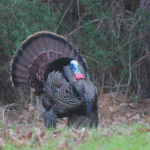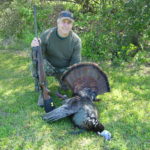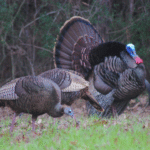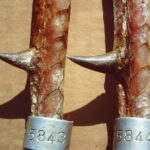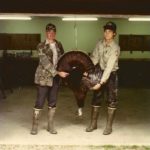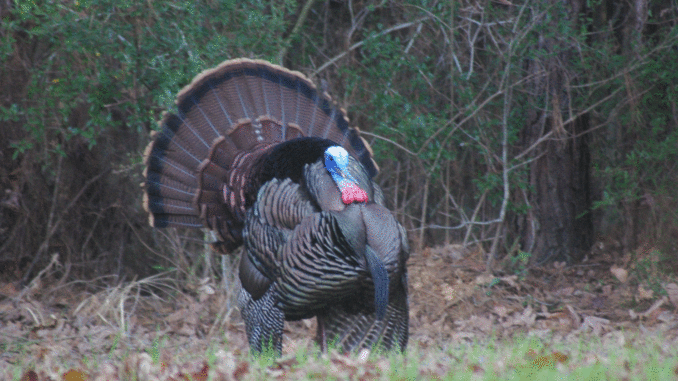
The 2011 turkey harvest was above the 2010 harvest and almost identical to the good harvest achieved in 2009, and despite poor production this past spring in many areas, the outlook for 2012 is good across the state.
Nov. 19 was the opening day of the deer gun season in Area 1, and I was sitting in my big ladder stand overlooking a long planted strip at Camp David that I have named the Wildlife Tram. A portion of this strip had been planted in American joint-vetch, and had been regularly used by the whitetails. The other portion had been planted with some grain forages for turkeys, and the turkeys had also been frequent users of this strip. In fact a hen and her four poults could often be seen feeding along on the strip since May.
Deer movement unfortunately was non-existent, but at 8 a.m. a turkey stepped out from the woods about 100 yards away and began “treading ground.” I could tell that it was larger than a hen, and with the binoculars could see the black-tipped breast feathers. I had thought that a couple of the poults I had been seeing might be jakes, and this sighting confirmed it. There was only a slight protrusion of the feathers on the breast where one day a beard would be growing.
Treading Ground is the term I use in reference to a tom imitating the breeding of a hen. A hen will squat on the ground and the tom will climb on her back and tread slowly with his feet along her sides and wings, and this action stimulates her to turn her cloaca outward so breeding can occur.
The young tom was thoroughly engrossed with the act and seemed to get even more excited when a second jake stepped out. This second jake also began treading ground, but with much less enthusiasm. The first jake finished, and immediately went into a full strut, easing over to the second jake. They then began to spar for a few seconds, and then broke it off and started heading my way. I was surprised when two more jakes and mama hen stepped out and joined them. I had brought my camera along, and was trying to get some photographs despite the poor lighting.
The four jakes, I call them the Band of Brothers, came closer to me, leaving mama by herself. They fed pretty close, then headed back to mama and they all walked off together. A hen has done well if she is able to raise two or three of her poults to adulthood, and this hen had done an exceptional job of raising these toms.
The spring turkey harvest is dependent upon the nesting success two years prior to the season. The reason for this is simple. While it is legal to shoot jakes, many veteran hunters do not, knowing that these young toms have a good chance of becoming longbeards in a year or two. For the most part, jakes are not involved with the breeding that goes on in the spring, and are not subject to the gunning pressure like adult birds.
Consequently, a year of good production will mean good hunting the following season as these young toms become adult gobblers. For example, since poult production in 2009 was fair and the 2010 jake harvest low, a good number of adult toms were available for hunters in 2011, and indeed hunter success was good.
Poult production survey
Poult production is determined from turkey observations during the summer months by observers throughout the state in the various turkey habitat sites. The state consists of five habitat sites: the Western Longleaf Pine, the Northern MS Delta, the Northwestern loblolly/shelterwood Hardwoods, the Southern Atchafalaya/Lower MS Delta and the Southeastern Loblolly Pine site. Poult production can vary within a habitat site.
While the 2011 harvest was good, the harvest was down in the northeastern and northwestern parishes where poult production had been poor in 2009. LDWF biologists thought the 2011 harvest would actually be down across the state because the poult production in 2009 was below their long-term average, but the harvest was surprisingly good.
Poult production in 2010 was fair in all habitat regions except the Atchafalaya/Lower MS Delta site, and so a good harvest is anticipated for the 2012 season, according to Jimmy Stafford, the LDWF turkey biologist. Stafford says it might even be better than the 2011 season.
Unfortunately, it is not looking good for the 2013 season because the 2011 poult survey documented poor production in all habitat regions except for the northwest parishes. The Poult Production Survey is dependent on good observations and an adequate number of observations, so the poor production documented in a particular habitat region may vary within a parish. For instance, it appears that the 2011 production was fair to good in East Feliciana Parish, but as a whole southeast Louisiana poult production was rated poor.
Long-term turkey outlook
I sat down with Stafford and Mark Bible, area supervisor for Pearl River WMA, at Camp David one evening in November over a meal of fried catfish and jambalaya, and we discussed the past and current status of the wild turkey in Louisiana.
Stafford grew up in Washington Parish in the 1960s and 1970s, and began turkey hunting at the age of 4. I was the district supervisor for the Florida Parishes when we hired Stafford as a wildlife specialist on Pearl River working under Bible.
He has moved up the ranks, and is now the head turkey biologist for LDWF, and represents our state on the Southeast Wild Turkey Study Group. He is familiar with the work and activities in the other southeastern states, and knows what is going on.
All three of us experienced some of the best turkey hunting in the state on Pearl River in the mid to late 1980s. We all experienced the impact of Hurricane Katrina on this management area, so Stafford has seen the best and the worst in our state.
Stafford sees the long-term turkey population trend to be on the decline, primarily due to habitat issues across the state. Urbanization is on the rise everywhere, but especially Southeast Louisiana following Katrina. The Florida Parishes have historically been a stronghold for turkeys in the state, but with urbanization, the habitat is becoming heavily fragmented.
Stafford is pleased that the WRP program, conversion of agricultural lands back to hardwoods, is increasing in the northeast and Mississippi Delta, and this is good news for turkey hunters.
Louisiana has much less turkey habitat than most of other southeastern states; consequently, we are somewhat at the bottom of the list regarding the wild turkey. It is difficult for turkeys to expand in fragmented forested habitat.
The Conservation Reserve Program did create some problems for turkey habitat in Louisiana, but Stafford says that the maturing of the CRP forest lands across the state, especially in East and West Feliciana, has resulted in some declining populations to stabilize and even increase in numbers.
For the most part, the state is finished with the Turkey Restocking Program, but Stafford does continue to go out and survey habitat to see if a release of turkeys could benefit the region. Predators are often blamed for declining populations, but Stafford says the main issue is habitat. I know at Camp David, we have plenty of coyotes, hogs, gray foxes and bobcats, but hens appear to be successful despite all these predator species.
Careful management of the hunting season is an important issue for our state. We need to be sure that hunting does not impact the breeding season; the goal is to have most of the hens bred prior to opening the season. While turkey hunters like an early opening for the season, generally around March 15, it might not be in the best interest of our population in this state to have a real early opening day.
I also asked Stafford about the long-range outlook for Pearl River. He does not see the area returning to the glory days that it once experienced, again primarily due to habitat conditions not only on the area but in adjacent Mississippi. Currently the area has a limited youth hunt season, and within a couple of years, there may be a limited lottery season for other hunters.
The 2012 season
The 2012 outlook is good. The season opens statewide on March 24, and most of the state will have a 30-day season. The northwest portion of the state and Washington and St. Tammany parishes will have a short 23-day season, and the upper Mississippi Delta parishes that are open will have a 15-day season. The youth hunt and physically challenged hunts will take place on March 17-18 on private lands.
Of course the public lands, state wildlife management areas, the Kisatchie National Forest and some of the national wildlife refuges, have separate turkey seasons, so it is a must that a hunter obtain a copy of the 2012 Turkey Regulations and know when the season is open on the area he wants to hunt. Since many areas operate under a lottery system, it is important for hunters to submit their applications in a timely fashion, both for the youth lottery hunts and the regular season hunts.
Stafford recommends the old stand-by public lands for turkey hunting: Fort Polk, Jackson-Bienville, Tunica Hills, Big Lake and Tensas. While Sherburne has been a good area for turkey hunting, poult production has been down the past two years, and the area has been impacted by hurricanes, so the season dates have been reduced. There are only two weekends for lottery hunting and one open weekend for all other hunters.
There is a lot of national forest land in this state, and Stafford is optimistic that this land can have the turkey populations like some of the national forest lands in other states. Much of our national forest land is being restored with longleaf pine habitat, which is great for turkeys, but it must be properly managed. Stafford believes that too much of the habitat is being annually burned, and this activity needs to be better regulated. Burning is good for the forest and wildlife, but burning a tract of forest land year after year does not benefit the wildlife.
